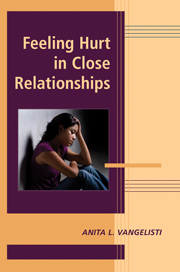Book contents
- Frontmatter
- Contents
- List of Contributors
- Foreword
- PART I INTRODUCTION
- PART II CONCEPTUALIZING HURT
- PART III HURTFUL ACTS
- PART IV HURT IN RELATIONAL CONTEXTS
- 12 Aggression and Victimization in Children's Peer Groups: A Relationship Perspective
- 13 Haven in a Heartless World? Hurt Feelings in the Family
- 14 Hurt Feelings in Adult Friendships
- 15 When Love Hurts: Understanding Hurtful Events in Couple Relationships
- 16 Hurt in Postdivorce Relationships
- PART V HURT IN APPLIED CONTEXTS
- Author Index
- Subject Index
- References
13 - Haven in a Heartless World? Hurt Feelings in the Family
from PART IV - HURT IN RELATIONAL CONTEXTS
Published online by Cambridge University Press: 04 August 2010
- Frontmatter
- Contents
- List of Contributors
- Foreword
- PART I INTRODUCTION
- PART II CONCEPTUALIZING HURT
- PART III HURTFUL ACTS
- PART IV HURT IN RELATIONAL CONTEXTS
- 12 Aggression and Victimization in Children's Peer Groups: A Relationship Perspective
- 13 Haven in a Heartless World? Hurt Feelings in the Family
- 14 Hurt Feelings in Adult Friendships
- 15 When Love Hurts: Understanding Hurtful Events in Couple Relationships
- 16 Hurt in Postdivorce Relationships
- PART V HURT IN APPLIED CONTEXTS
- Author Index
- Subject Index
- References
Summary
Hurt feelings are ubiquitous in family relationships. The emotional investment that family members make in one another typically is intense and matched only by the emotional vulnerability it involves. In the ups and downs of daily life, irritation and conflict are frequent occurrences, and vulnerability heightens the potential for bruised feelings and sometimes agonizing emotional pain. Mothers of preschoolers experience an aversive event every few minutes, with major conflicts occurring as often as three times in an hour (Patterson, 1980), and although the rates decline with older children it is safe to say that parent–child interaction is rife with hurt feelings. Aversive interactions between young siblings may be even more frequent (Martin & Ross, 1996, 2005; Patterson, 1980). Aversive experiences that occur with such frequency must have a significant impact on the developing child, and a basic premise of research on children's relationships is that they are key learning experiences about self and social relationships and hence an important risk factor for development in these domains. Understanding the precise nature of these learning experiences has been a major aim of research on children's relationships with their parents and siblings. Our purpose in this chapter is to review research relevant to understanding the nature of these learning experiences and their effects on development.
- Type
- Chapter
- Information
- Feeling Hurt in Close Relationships , pp. 260 - 287Publisher: Cambridge University PressPrint publication year: 2009
References
- 5
- Cited by



